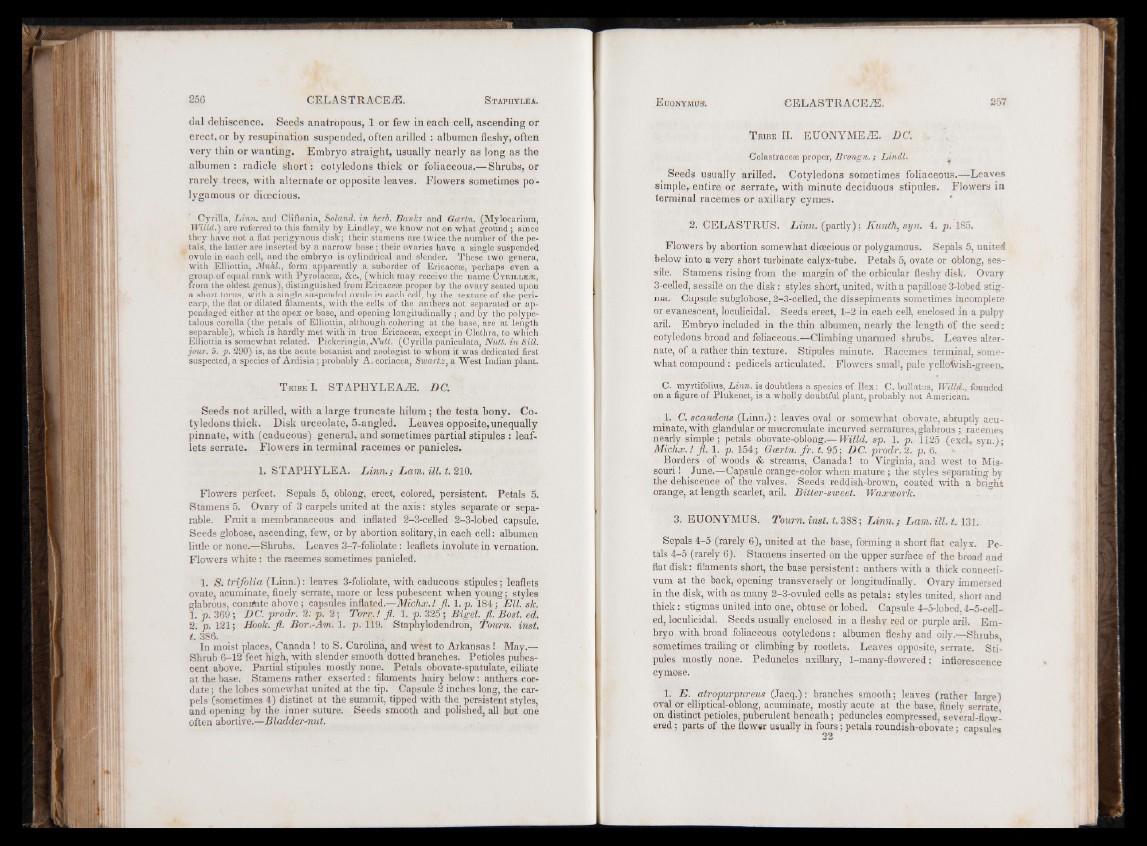
dal dehiscence. Seeds anatropous, 1 or few in each cell, ascending or
erect, or by resupination suspended, often arilled : albumen fleshy, often
very thin or wanting. Embryo straight, usually nearly as long as the
albumen : radicle short: cotyledons thick or foliaceous.—Shrubs, or
rarely trees, with alternate or opposite leaves. Flowers sometimes polygamous
or dioecious.
7 Cyrilla, Linn, and Cliftonia, Soland. in herb. Banks and Gartn. (Mylocarium,
Willd.) are referred to this family by Lindley, we know not on what ground ; since
they have not a flat perigynous disk; their stamens are twice the number of the petals,
the latter are inserted by a narrow base; their ovaries have a single suspended
ovule in each cell, and thp embryo is cylindrical and slender. These two genera,
with Elliottia, Muhl., form apparently a suborder of Ericace.ee, perhaps even a
group of equal rank with Pyrolaceee, &c., (which may receive the name Cvrillea:,
from the oldest genus), distinguished from Ericaceae proper by the ovary seated upon
a short torus, with a single suspended ovule in each cell, by the texture of the pericarp,
the flat or dilated filaments, with the cells of the anthers not separated or ap-
pendaged either at the apex or base, and opening longitudinally ; and by the polype-
talous corolla (the petals of Elliottia, although cohering at the base, are at length
separable), which is hardly met with in true Ericaceae, except in Cletbra, to which
Elliottia is somewhat related. Pickeringia, Nutt. (Cyrilla paniculata, Nutt, in Sill,
jour. 5. p. 290) is, as the acute botanist and zoologist to whom it was dedicated first
suspected, a species of Ardisia ; probably A. coriacea, Swartz, a West Indian plant.
T ribe I. STAPHYLEAiE. DC.
Seeds not arilled, with a large truncate hilum ; the testa bony. Cotyledons
thick. Disk urceolate, 5-angled. Leaves opposite,unequally
pinnate, with (caducous) general, and sometimes partial stipules : leaf,
lets serrate. Flowers in terminal racemes or panicles.
1. STAPHYLEA. Lin n .; Lam. ill. t. 210.
Flowers perfect. Sepals 5, oblong, erect, colored, persistent. Petals 5.
Stamens 5. Ovary of 3 carpels united at the axis: styles separate or separable.
Fruit a membranaceous and inflated 2-3-celled 2-3-lobed capsule.
Seeds globose, ascending, few, or by abortion solitary, in each cell: albumen
little or none.—Shrubs. Leaves 3-7-foliolate : leaflets involute in vernation.
Flowers white: the racemes sometimes panicled.
1. S': trifolia (Linn.): leaves 3-foliolate, with caducous stipules; leaflets
ovate, acuminate, finely serrate, more or less pubescent when young; styles
glabrous, comfate above; capsules inflated.—Michx.! fl. 1. p. 184; Ell. sk.
1. p. 369; DC. prodr. 2: p. 2; Torr.l fl. 1. p. 325; Bigel. fl. Bost. ed.
2. p. 121; Hook. fl. Bor.-Am. 1. p . 119. Staphylodendron, Tourn. inst.
t. 386. j 44 a
In moist places, Canada ! to S. Carolina, and west to Arkansas ! May.—
Shrub 6-12 feet high, with slender smooth dotted branches. Petioles pubescent
above. Partial stipules mostly none. Petals obovate-spatulate, ciliate
at the base. Stamens rather exserted: filaments hairy below: anthers cordate
; the lobes somewhat united at the tip. Capsule 2 inches long, the carpels
(sometimes 4) distinct at the summit, tipped with the persistent styles,
and opening by the inner suture. Seeds smooth and polished, all but one
often abortive.—Bladder-nut.
T ribe II. EUONYMEZE. DC.
Celastracese proper, Brongn.; Lindl. '
Seeds usually arilled. Cotyledons sometimes foliaceous.— Leaves
simple, entire or serrate, with minute deciduous stipules. Flowers in
terminal racemes or axillary cymes.
2. CELASTRUS. Linn, (partly) : Kunth, syn. 4. p. 185.
Flowers by abortion somewhat dioecious or polygamous. Sepals 5, united
below into a very short turbinate calyx-tube. Petals 5, ovate or oblong, sessile.
Stamens rising from the margin of the orbicular fleshy disk. Ovary
3-celled, sessile on the disk : styles short, united, with a papillose 3-lobed stigma.
Capsule subglobose, 2-3-celled, the dissepiments sometimes incomplete
or evanescent, loculicidal. Seeds erect, 1-2 in each cell, enclosed in a pulpy
aril. Embryo included in the thin albumen, nearly the length of the seed:
cotyledons broad and foliaceous.—Climbing unarmed shrubs. Leaves alternate,
of a rather thin texture. Stipules minute. Racemes terminal, somewhat
compound: pedicels articulated. Flowers small, pale yelloiyish-green.
C. myrtifolius, Linn, is doubtless a species of Ilex: C. bullatus, Willd., founded
on a figure of Plukenet, is a wholly doubtful plant, probably not American.
1. C. scandens (Linn.) : leaves oval or somewhat obovate, abruptly acuminate,
with glandular or mucronulate incurved serratures, glabrous ; racemes
nearly simple; petals obovate-oblong.— Willd. sp. 1. p. 1125 (excb, syn.);
Michx.! fl. 1. p. 154; Geertn. fr . t. 95; DC. prodr. 2. p. 6.
Borders of woods & streams, Canada! to Virginia, and west to Missouri
! June.—Capsule orange-color when mature ; the styles separating by
the dehiscence of the valves. Seeds reddish-brown, coated with a bright
orange, at length scarlet, aril. Bitter-sweet. Waxwork.
3. EUONYMUS. Tourn. inst. t. 388; Lin n .; Lam. ill. t. 131.
Sepals 4-5 (rarely 6), united at the base, forming a short flat calyx. Petals
4-5 (rarely 6). Stamens inserted on the upper surface of the broad and
flat disk: filaments short, the base persistent: anthers with a thick connecti-
vum at the back, opening transversely or longitudinally. Ovary immersed
in the disk, with as many 2-3-ovuled cells as petals: styles united, short and
thick: stigmas united into one, obtuse or lobed. Capsule 4r-5-lobed, 4-5-cell-
ed, loculicidal. Seeds usually enclosed in a fleshy red or purple aril. Embryo
with broad foliaceous cotyledons : albumen fleshy and oily.—Shrubs
sometimes trailing or climbing by rootlets. Leaves opposite, serrate. Stipules
mostly none. Peduncles axillary, 1-many-flowered: inflorescence
cymose.
1. E. atropurpureus (Jacq.)r branches smooth; leaves (rather large)
oval or elliptical-oolong, acuminate, mostly acute at the base, finely serrate
on distinct petioles, puberulent beneath; peduncles compressed, several-flowered
; parts of the flower usually in fours; petals roundish-obovate; capsules